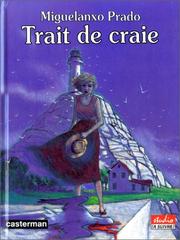| Listing 1 - 10 of 24 | << page >> |
Sort by
|
Dissertation
Year: 1991 Publisher: Aachen : Rheinisch-Westfälische Technische Hochschule Aachen [R.W.T.H.], Mathematisch- Naturwissenschaftliche Fakultät,
Abstract | Keywords | Export | Availability | Bookmark
 Loading...
Loading...Choose an application
- Reference Manager
- EndNote
- RefWorks (Direct export to RefWorks)
Radio communication --- Radio relay systems --- Data transmission --- Radio communication --- Radio relay systems --- Data transmission
Book
ISBN: 9782915830972 2915830975 Year: 2015 Publisher: Paris : l'Échappée,
Abstract | Keywords | Export | Availability | Bookmark
 Loading...
Loading...Choose an application
- Reference Manager
- EndNote
- RefWorks (Direct export to RefWorks)
Counterculture --- Contre-culture --- Grogan, Emmett, --- Diggers (San Francisco, Calif.)
Book
ISBN: 2731609281 9782731609288 Year: 1991 Publisher: Genève: Les Humanoïdes associés,
Abstract | Keywords | Export | Availability | Bookmark
 Loading...
Loading...Choose an application
- Reference Manager
- EndNote
- RefWorks (Direct export to RefWorks)
Avec Prado, rues, villes, stades, prétoires, squares, sont des arènes dont mamans, amis, voisins, mamies, nous-mêmes sommes les horribles et quelconques gladiateurs. Qui scalpera l'autre ? Innocent si possible... Prado étudie l'architecture pendant quatre ans, écrit des nouvelles et se voue à la peinture avant de mettre son fabuleux talent au service de la bande dessinée. Révélation de la BD espagnole en 1988 avec son premier album, Chienne de vie (Humanoïdes Associés), il récoltera au fil des années toutes sortes de récompenses. En 1988, il se révèle un conteur de science-fiction remarquablement inventif avec Demain les dauphins. En 1989, il publie Manuel Montano chez Casterman et revient à ses chroniques délirantes et féroces, en couleur cette fois, avec C'est du sport (Humanoïdes Associés). En 1990, paraît une compilation d'histoires courtes, Stratos, suivie en 1991 de l'album Y a plus de justice (Humanoïdes), caricature futuriste d'un système économique contemporain. En 1993, Casterman publie l'album Trait de craie, pour lequel Prado reçoit Le Prix des libraires BD 93, l'Alph-art du meilleur album étranger d'Angoulême 94 et le Prix spécial du jury du Festival de Sierre 94. En 1995, Prado fait son entrée dans la bandes dessinée pour enfants chez Casterman en adaptant le célèbre Pierre et le loup écrit et composé par Prokofiev en 1936. En 1996 paraît chez Casterman Quotidien délirant.
Periodical
Abstract | Keywords | Export | Availability | Bookmark
 Loading...
Loading...Choose an application
- Reference Manager
- EndNote
- RefWorks (Direct export to RefWorks)
Book
ISBN: 2203338555 Year: 1993 Publisher: Tournai Casterman
Abstract | Keywords | Export | Availability | Bookmark
 Loading...
Loading...Choose an application
- Reference Manager
- EndNote
- RefWorks (Direct export to RefWorks)

ISBN: 2203388552 Year: 1994 Publisher: Tournai Casterman
Abstract | Keywords | Export | Availability | Bookmark
 Loading...
Loading...Choose an application
- Reference Manager
- EndNote
- RefWorks (Direct export to RefWorks)
Book
ISBN: 2203388773 Year: 1996 Publisher: Tournai Casterman
Abstract | Keywords | Export | Availability | Bookmark
 Loading...
Loading...Choose an application
- Reference Manager
- EndNote
- RefWorks (Direct export to RefWorks)
Book
ISBN: 9782800168630 Year: 2016 Publisher: Marcinelle Dupuis
Abstract | Keywords | Export | Availability | Bookmark
 Loading...
Loading...Choose an application
- Reference Manager
- EndNote
- RefWorks (Direct export to RefWorks)
Book
ISBN: 9782800168678 Year: 2016 Publisher: Marcinelle Dupuis
Abstract | Keywords | Export | Availability | Bookmark
 Loading...
Loading...Choose an application
- Reference Manager
- EndNote
- RefWorks (Direct export to RefWorks)

ISBN: 1280944153 9786610944156 1402059698 140205968X Year: 2007 Publisher: Dordrecht, The Netherlands : Springer,
Abstract | Keywords | Export | Availability | Bookmark
 Loading...
Loading...Choose an application
- Reference Manager
- EndNote
- RefWorks (Direct export to RefWorks)
This book provides a solid overview of mobile phone programming targeting both academia and industry. Mobile Phone Programming covers all commercial realizations of Symbian, Windows Mobile and Linux platforms. Each programming language (JAVA, Python, C/C++) and a set of development environments are introduced “step by step” making developers familiar with current limitations, pitfalls, and challenges. Each chapter contains examples and source code to rapidly make developers familiar with the most important concepts. Examples cover peer to peer networks, cooperative networking, cross layer protocol design, key challenges such as power consumption, and sensor networks for which a full hardware and software implementation is provided. Whether you are an experienced developer or an advanced student Mobile Phone Programming will be your key reference for successfully entering the world of software development for mobile devices.
Cell phones. --- Wireless communication systems. --- Communication systems, Wireless --- Wireless data communication systems --- Wireless information networks --- Wireless telecommunication systems --- Telecommunication systems --- Cell telephones --- Cellphones --- Cellular phones --- Cellular radio --- Cellular telephones --- Mobile phones --- Mobiles (Telephones) --- Phones, Cell --- Telephones, Cell --- Wireless phones --- Radio --- Telephone --- Transmitter-receivers --- Telecommunication. --- Microwaves. --- Computer science. --- Communications Engineering, Networks. --- Signal, Image and Speech Processing. --- Microwaves, RF and Optical Engineering. --- Programming Techniques. --- Informatics --- Science --- Hertzian waves --- Electric waves --- Electromagnetic waves --- Geomagnetic micropulsations --- Radio waves --- Shortwave radio --- Electric communication --- Mass communication --- Telecom --- Telecommunication industry --- Telecommunications --- Communication --- Information theory --- Telecommuting --- Electrical engineering. --- Signal processing. --- Image processing. --- Speech processing systems. --- Optical engineering. --- Computer programming. --- Mechanical engineering --- Computational linguistics --- Electronic systems --- Modulation theory --- Oral communication --- Speech --- Telecommunication --- Singing voice synthesizers --- Pictorial data processing --- Picture processing --- Processing, Image --- Imaging systems --- Optical data processing --- Processing, Signal --- Information measurement --- Signal theory (Telecommunication) --- Electric engineering --- Engineering --- Computers --- Electronic computer programming --- Electronic data processing --- Electronic digital computers --- Programming (Electronic computers) --- Coding theory --- Programming
| Listing 1 - 10 of 24 | << page >> |
Sort by
|

 Search
Search Feedback
Feedback About UniCat
About UniCat  Help
Help News
News